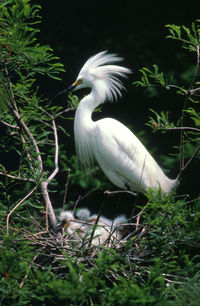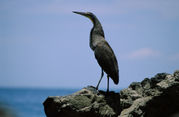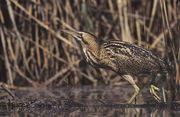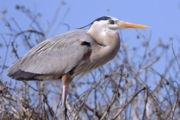Heron
2008/9 Schools Wikipedia Selection. Related subjects: Birds
| Herons | ||||||||||||||||
|---|---|---|---|---|---|---|---|---|---|---|---|---|---|---|---|---|
 Snowy Egret, Egretta thula. Note the chicks in the nest.
|
||||||||||||||||
| Scientific classification | ||||||||||||||||
|
||||||||||||||||
| Genera | ||||||||||||||||
|
About 17, see text |
||||||||||||||||
| Synonyms | ||||||||||||||||
|
Cochlearidae |
The herons are wading birds in the Ardeidae family. Some are called egrets or bitterns instead of herons. Within the family, all members of the genera Botaurus and Ixobrychus are referred to as bitterns, and - including the Zigzag Heron or Zigzag Bittern - are a monophyletic group within the Ardeidae. However, egrets are not a biologically distinct group from the herons, and tend to be named differently because they are mainly white and/or have decorative plumes, and while having the same build as the larger herons tend to be smaller.
The classification of the individual heron/egret species is fraught with difficulty, and there is still no clear consensus about the correct placement of many species into either of the two major genera, Ardea and Egretta. Similarly, the relationship of the genera in the family is not completely resolved. However, one species formerly considered to constitute a separate monotypic family Cochlearidae, the Boat-billed Heron, is now regarded as a member of the Ardeidae.
Although herons resemble birds in some other families, such as the storks, ibises and spoonbills, they differ from these in flying with their necks retracted, not outstretched. They are also one of the bird groups that have powder down.
The members of this family are mostly associated with wetlands, and prey on fish, frogs and other aquatic species. Some, like the Cattle Egret and Black-headed Heron, also take large insects, and are less tied to watery environments. Some members of this group nest colonially in trees, others, notably the bitterns, use reedbeds.
In February 2005, the Canadian scientist Dr. Louis Lefebvre announced a method of measuring avian IQ in terms of their innovation in feeding habits. Herons were named among the most intelligent birds based on this scale, reflecting a wide variety, flexibility and adaptiveness to acquire food{{ ref}}.
Taxonomy and systematics
Analyses of the skeleton, mainly the skull, suggested that the Ardeidae could be split into a diurnal and a crepuscular/ nocturnal group which included the bitterns. From DNA studies and skeletal analyses focusing more on bones of body and limbs, this grouping has been revealed as incorrect. Rather, the similarities in skull morphology reflect convergent evolution to cope with the different challenges of daytime and nighttime feeding. Today, it is believed that three major groups can be distinguished, which are (from the most primitive to the most advanced):
- tiger herons and the boatbill
- bitterns
- day-herons and egrets, and night-herons
The night herons could warrant separation as subfamily Nycticoracinae, as it was traditionally done. However, the position of some genera (e.g. Butorides or Syrigma) is unclear at the moment, and molecular studies have until now suffered from a small number of studied taxa. Especially the relationship among the ardeine subfamily is very badly resolved. The arrangement presented here should be considered provisional.
Subfamily Tigrisomatinae
- Genus Cochlearius - Boat-billed Heron
- Genus Tigrisoma - typical tiger-herons (3 species)
- Genus Tigriornis - White-crested Tiger-heron
- Genus Zonerodius - New Guinea Tiger-heron
Subfamily Botaurinae
- Genus Zebrilus - Zigzag Heron
- Genus Ixobrychus - small bitterns (8 living species, 1 recently extinct)
- Genus Botaurus - large bitterns (4 species)
Subfamily Ardeinae
- Genus Zeltornis (fossil)
- Genus Nycticorax typical night-herons (2-4 living species, 5 recently extinct; includes Nyctanassa)
- Genus Gorsachius - Asian night-herons (3-5 species)
- Genus Butorides - green-backed herons (3 species; sometimes included in Ardea)
- Genus Agamia - Agami Heron
- Genus Pilherodius - Capped Heron
- Genus Ardeola pond-herons (6 species)
- Genus Bubulcus - cattle-egrets (1-2 species, sometimes included in Ardea)
- Genus Proardea (fossil)
- Genus Ardea - typical herons (11-17 species)
- Genus Syrigma - Whistling Heron
- Genus Egretta - typical egrets (7-13 species)
- Genus undetermined
- Easter Island Heron, Ardeidae gen. et sp. indet. ( prehistoric)
Fossil herons of unresolved affiliations:
- Xenerodiops (Early Oligocene of Fayyum, Egypt)
- "Anas" basaltica (Late Oligocene of "Warnsdorf", Czechia)
- Ardeagradis
- Calcardea
- Proardeola - possibly same as Proardea
Other prehistoric and fossil species are included in the respective genus accounts.


